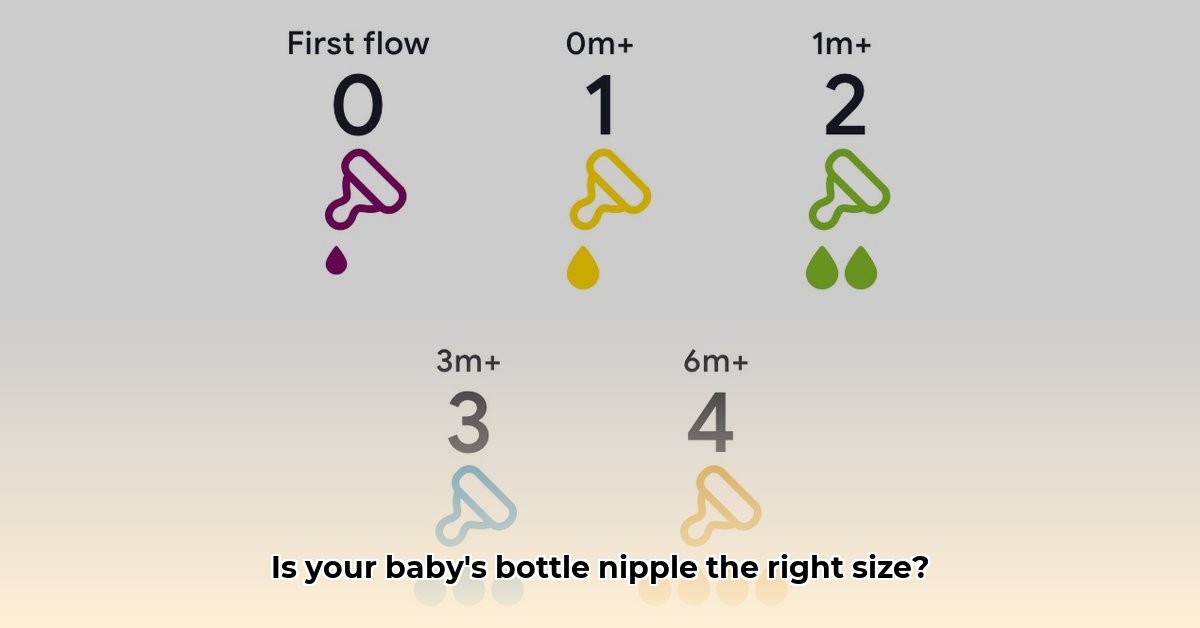Is your baby struggling with bottle feeding? Are they gulping too fast, getting frustrated, or taking forever to finish? Choosing the right nipple size can make all the difference. This comprehensive guide will walk you through everything you need to know, from understanding flow rates to recognizing when it’s time for a change. We’ll empower you to make informed decisions and ensure a comfortable, happy feeding experience for both you and your baby.
Understanding Nipple Sizes and Flow Rates
Picking the right nipple size is crucial for your baby’s comfort and successful feeding. Just like finding the right shoe size, the correct nipple flow allows your baby to drink comfortably at their own pace. A nipple that’s too fast can cause choking, spitting up, and digestive issues. A nipple that’s too slow can lead to frustration, fatigue, and inadequate milk intake. This guide will help you navigate the world of bottle nipple sizes, ensuring a positive feeding experience for your little one.
Quick Guide: Nipple Sizes by Brand
This chart provides a general overview of nipple sizes from popular brands. Remember, these are just guidelines. Every baby develops at their own pace, so observing your baby’s cues is essential.
| Brand | Level/Size | Age (Approximate) | Flow Rate |
|---|---|---|---|
| Dr. Brown’s | Preemie/Level 0 | Premature | Extra Slow |
| Level 1 | 0+ Months | Slow | |
| Level 2 | 3+ Months | Medium | |
| Level 3 | 6+ Months | Fast | |
| Level 4/Y-Cut | 9+ Months | Fastest/Thick Liquids | |
| Philips Avent | Newborn | 0+ Months | Slow |
| Slow | 1+ Month | Slower Medium | |
| Medium | 3+ Months | Medium | |
| Fast | 6+ Months | Fast | |
| Variable | 6+ Months | Adjustable | |
| Tommee Tippee | Size 1/Slow | 0+ Months | Slow |
| Size 2/Medium | 3+ Months | Medium | |
| Size 3/Fast | 6+ Months | Fast | |
| Size 4/X-Cut/Variable | 9+ Months | Fastest/Variable |
Always refer to the manufacturer’s latest recommendations, as they may update their guidelines periodically.
Decoding the Signs: Does Your Baby Need a Nipple Change?
Unsure if your baby’s nipple is the right fit? Look for these clues:
Signs a Nipple is Too Slow:
- Prolonged Feedings: Feedings consistently last longer than 20-30 minutes.
- Mid-Feed Fatigue: Baby dozes off during feeding due to exhaustion, not fullness.
- Frustration: Baby pulls away from the bottle, cries, or shows signs of irritability.
- Poor Weight Gain: Baby may not be getting enough milk due to the slow flow.
- Nipple Collapse: The nipple collapses inward during feeding.
(Include images/illustrations of a baby exhibiting these signs)
Signs a Nipple is Too Fast:
- Gulping and Gagging: Baby gulps, gasps, or chokes during feeding.
- Milk Overflow: Milk dribbles out of baby’s mouth.
- Overwhelmed Baby: Baby arches their back, pulls away, or seems distressed.
- Digestive Upset: Baby experiences increased gas, spitting up, or reflux.
- Struggling for Breath: Difficulty breathing while feeding, requiring frequent pauses for air.
(Include images/illustrations of a baby exhibiting these signs)
Paced Feeding: Mimicking Breastfeeding with a Bottle
Paced feeding is a valuable technique, especially when bottle feeding. It allows your baby to control the pace and mimic the natural flow of breastfeeding, reducing the risk of overfeeding and digestive issues.
How to Pace Feed:
- Hold your baby in a semi-upright position.
- Hold the bottle horizontally, allowing milk to fill only the tip of the nipple.
- Allow pauses for your baby to breathe and rest.
Choosing and Transitioning: A Step-by-Step Guide
How to Choose the Right Nipple:
- Consider Age: Use the age recommendations as a starting point.
- Observe Your Baby: Pay attention to their feeding cues (see signs above).
- Factor in Milk Type: Thicker liquids may require a faster flow nipple.
- Experiment: Don’t hesitate to try different nipple sizes.
(Include a decision tree/flowchart)
Transitioning to a New Nipple Size:
- Gradual Introduction: Offer the new nipple for one feeding a day.
- Alternate: Switch between the old and new nipple during a single feeding.
- Patience: It may take time for your baby to adjust.
Cleaning and Care: Keeping Things Hygienic
Proper cleaning and sterilization are crucial for preventing bacterial growth.
- Wash: Thoroughly wash nipples with warm, soapy water after each use.
- Sterilize: Sterilize nipples according to manufacturer instructions (boiling, sterilizer).
- Replace: Replace nipples every 2-3 months, or sooner if damaged.
(Include images/a short video demonstrating cleaning and sterilizing)
Frequently Asked Questions:
- How often should I replace bottle nipples? Every 2-3 months, or sooner if there are signs of wear and tear.
- Are different brand nipples and bottles compatible? Not always. Consult the manufacturer guidelines.
- My baby refuses the new nipple. What should I do? Try again later, or mix a small amount of expressed milk or formula with the new nipple to make it more appealing. Don’t force it.
- Can nipple size affect breastfeeding? Possibly. Some studies suggest a faster flow nipple can lead to nipple preference or confusion if not combined with paced feeding.
- Should I be concerned if my baby seems to be feeding constantly with a slow flow nipple? It’s possible the slow flow means your little one is hungry or working hard for not enough food. Consult a pediatrician to eliminate underlying causes and discuss transitioning nipple sizes.
Conclusion: Trust Your Instincts
Choosing the right nipple size is a journey of observation and adjustment. While this guide offers valuable information, your baby’s cues and your instincts are your best resources. Always consult with your pediatrician if you have any concerns about your baby’s feeding or development. They can offer personalized guidance and address any specific questions or concerns.
- The Best Bento Box Price For Your Perfect Packed Lunch - December 15, 2025
- Bento Box Shopping Tips for Smart and Stylish Lunch Prep - December 14, 2025
- Bento Box Trays Streamline Restaurant Meal Presentation and Transport - December 13, 2025










